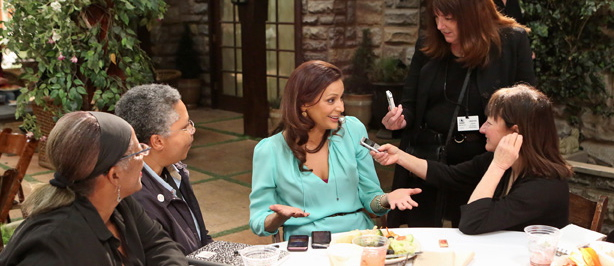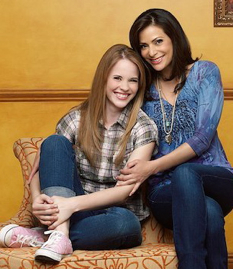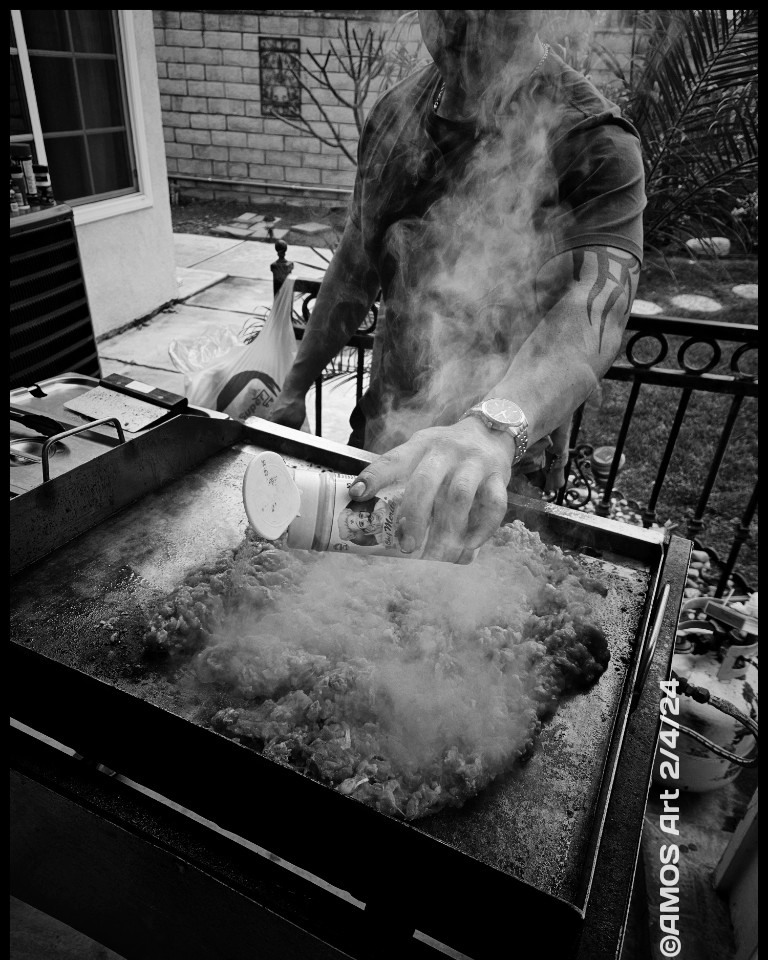Switched at Birth is the first TV series to integrate deaf culture and American Sign Language into its weekly storyline, and that’s no easy process. Now Constance Marie and the entire cast are telling a whole episode from the deaf POV.
The ABC Family drama Switched at Birth is well into its second season now, and from the beginning, Constance Marie, best known for being the light-hearted Mom on the George Lopez Show, attacked her role as single Mom Regina Vasquez. The hard work has paid off in many ways, she tells us…and changed her life.
The initial premise of Switched is a little complicated and extremely demanding for an actress. Almost twenty yeas ago, two couples have babies on the same day in the same hospital–one white, one Latino. The Latina baby is accidentally placed with the affluent white couple; the white child is placed with the single Latina mom…and that baby is deaf as well. The switch isn’t discovered until both girls are well into their teens, and suddenly the Latina mother–who’s had problems with alcohol and money–is living in the guest house of the rich white couple, and everyone is coping with the realities of mixing three cultures: Anglo, Latino…and deaf.
ABC Family has been telling some fascinating stories about this odd arrangement for more than a year now, and made the commitment from the outset to cast actual deaf actors in key roles, including Katie Leclerc as the deaf daughter, and adding Marlee Matlin–probably the best-known deaf actress in America–as a regular member of the cast as well. On March 4, Switched at Birth is taking it even farther: presenting an entire episode in American Sign Language, with a story about deaf rights at school as seen from the deaf characters’ perspective (with open captions for the hearing). It’s the first time this level of commitment has been undertaken by any mainstream scripted series. “I’ve been wanting to do an all-ASL episode since the series began, and the storyline we’ve been focusing on this season gave us the perfect opportunity,” said series creator and Executive Producer Lizzy Weiss. “It’s an exciting, visual, empowering story of kids who are different fighting back, and it allows our audience to experience the world as our deaf characters do. We’ve been building to this for 39 episodes and we’re all thrilled to be the first to try this.”
“I’m not sure I want to go back to work after having a baby,
but if I do, this is the project I want to do”
Though deaf characters have appeared in other series, even on a regular bass, this is the first time that deaf culture and ASL have played a key role in an ongoing, scripted series. And when we spoke to Constance Marie at the recent TCA get-together about the challenge of playing Regina, she talked freely about how hard it was.
“When I first read it,” she told us, “I was galvanized by it. I loved that my character was a survivor. Even though she had problems with alcohol and didn’t have as much money as everyone else, her daughter was the one who was raised properly. She was a wonderful role that represents Latino Moms and single Moms everywhere, and they deserve representation. I read it and thought, ‘I’m not sure I want to go back to work after having a baby, but if I do, this is the project I want to do.’”
Obviously Constance is already fluent in two languages, but given the premise of the show, the Latino aspects took a back seat to the clash between rich and poor and the clash between deaf and hearing. As Regina, she had to communicate in authentic, regionally accurate American Sign Language (ASL)–or actually SymCom, speaking and signing (smoothly) at the same time. Even more challenging, she had to play a hearing character who had been using ASL to communicate with her daughter for more than twelve years. She had to make it look easy.
“In the very beginning,” she told us. “I had absolutely no life. I didn’t want to offend the deaf community or the Latino community, or the large Latino deaf community that’s out there–I didn’t want to insult any of them, and I didn’t want to be half an actress. So I rehearsed in the shower, I rehearsed in my car. I rehearsed all the time, ‘cause I had to look like I’d done it for twelve years. And I was so good that they wrote even more scenes for me, and I ended up getting double tendonitis in my arms.”
What most people don’t know is that signing full-time, every day, is physically draining as well as mentally taxing. Katie Leclerc, the hearing-impaired woman who plays her daughter on the show, tried to warn her. “She said, ‘If you learn sign language as a student in school, you have no stress. But if you learn it later, as an adult, you have a 40% chance of getting arthritis. And I got tendonitis because I wasn’t learning like a regular person. I had to learn complete scenes in sign in a couple of days, and shoot for four hours straight. Even interpreters get breaks every twenty minutes. But it was just me, signing over and over and over again.” Eventually, doctors put Constance in special arm restraints that limited her ability to gesture and sign.
“It’s all about family, and family is all about love, no matter how dysfunctional. We’re all just doing our best”
It was a painful time for her, both literally and figuratively. At home, her two-year-old daughter would ask, “Is this the boo-boo hand? Can I hold it?” On set, the writers began to work her injury into the second-season Switched at Birth scripts. “It’s a wonderful story line for the deaf,” she says now. “Every parent suffers separation when a teenager pulls away, and we have that happening with the ASL, too, because Regina’s injured, and she can’t communicate with her daughter And the thing is, Regina promised that she would never leave Daphne alone in the hearing world ever but because of the injury, she had to.” Constance actually had to pause when she told us the story. “It’ll make me cry,” she said. “The sad statistic is that 70% of parents of deaf kids don’t learn sign language. But I just couldn’t do it anymore. I couldn’t turn doorknobs, start my car, do my hair. It’s slowly getting better, but with tendonitis you have to stop everything; I even have to wear the appliance when I sleep. But right now, it’s awesome for the story line, and we’re going with that.” In recent episodes, and in the all-ASL episode in March, viewers will see how Regina and Daphne deal with the injury.
Switched at Birth has become more than just a job for Constance Marie; it’s become a cause, a way of life. “The working Moms of America deserve a fucking monument,” she told us. “And yeah, I said ‘fucking.’ My own OB said it best: ‘Some days I feel like an amazing parent and a horrible doctor; other days, I feel like a horrible parent and amazing doctor.” It’s hard for every single Mom. I’m a product of a divorced working mother myself, and I learned: the buck stops here. And the show is homage to my own single working Mom.”
And Constance is proud of her work on Switched at Birth and the effect it’s already had on the audience. “I know already they’ve taken away a knowledge of ASL and the deaf community; they’re people just like us. I hope they also take away the message that just because you’re affluent doesn’t mean you don’t have any problems and just because you’re poor doesn’t mean you can be written off. It’s all about family, and family is all about love, no matter how dysfunctional. We’re all just doing our best.”
New episodes of Switched at Birth can be found on ABC Family on Mondays at 8P. The all-ASL edition will appear on Monday, March 4. You can see some of the recent episodes on line here, at ABCFamily.com.











